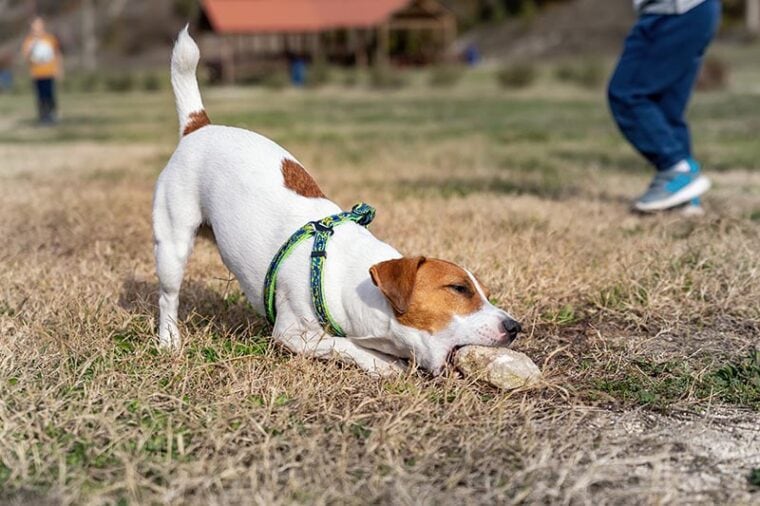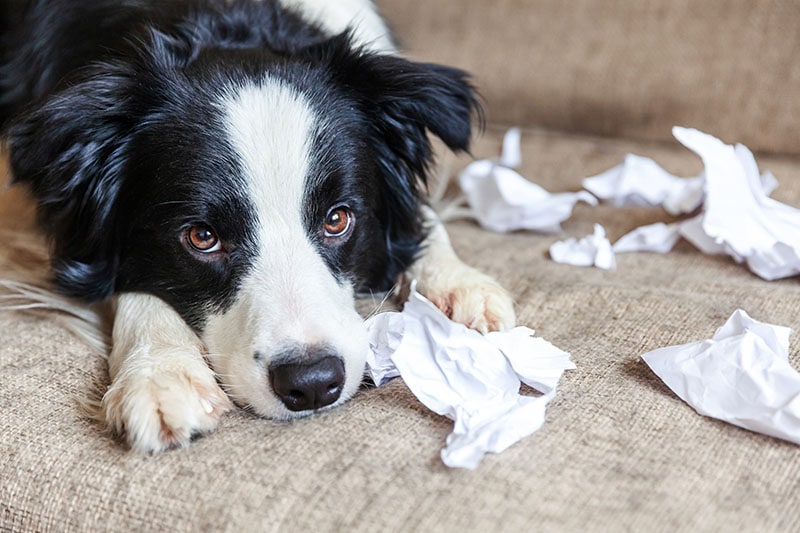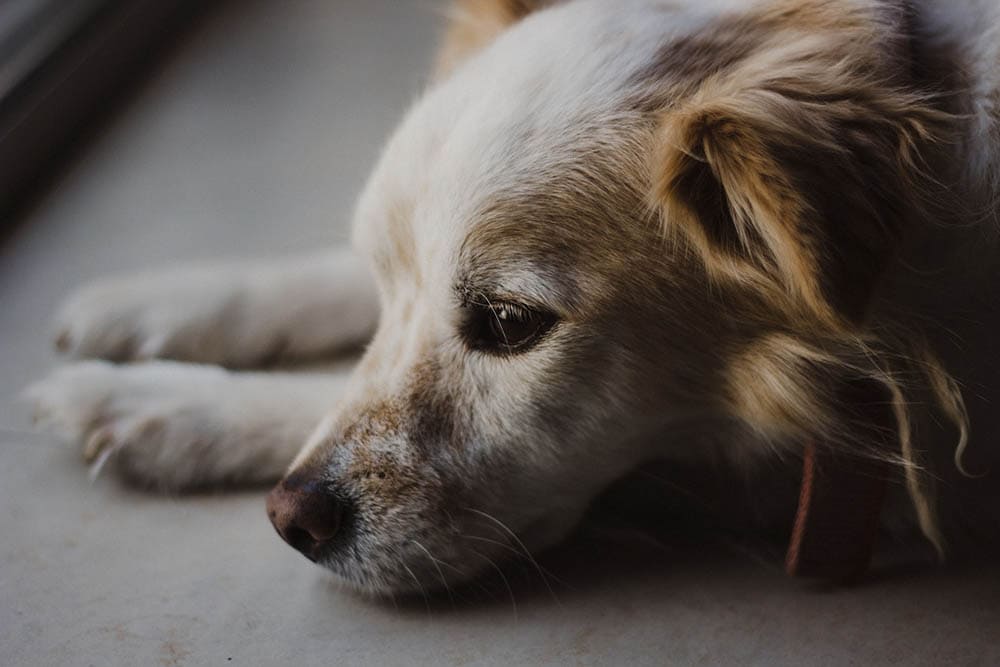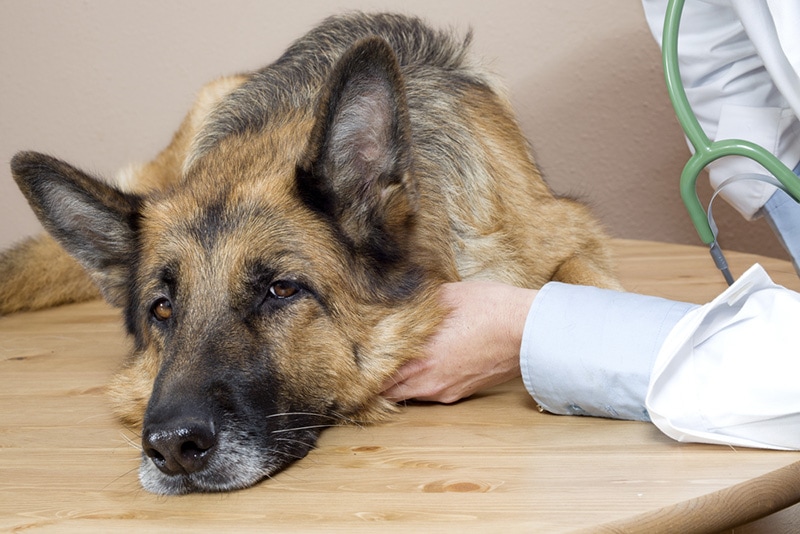
Dogs tend to eat things that are not part of their usual diet, commonly their own or another animal’s feces. This behavior is relatively normal, especially for young dogs.
However, dogs that regularly crave and consume non-food, inedible materials may be suffering from pica. For example, if your dog has swallowed a stone, that does not mean they suffer from pica, but if they do this regularly, it would be best to take your pet to the vet for an evaluation. Stones and wood are common materials that dogs with pica will consume.
Eating stones or other foreign objects can be dangerous not only for the teeth and soft tissues of your dog’s mouth but also for their digestive system. Ingesting stones or other non-edible items can lead to intestinal obstruction, vomiting, diarrhea, or even suffocation if the item is large enough to get stuck in your dog’s throat.
What Is Pica?
Pica is the compulsive ingestion of inedible substances or items, such as earth, chalk, paper, sand, stones, wood, rubber, clothing items (underwear and socks)1, washcloths, towels, bedding, balls, children’s toys, batteries, etc. It has been observed that dogs prefer objects that have their owner’s scent.
It is not a disorder of the digestive system nor a nutritional problem, but rather a psychological anomaly. Pica can also be a sign of other diseases, such as anemia.
The name of the condition comes from the Latin scientific name of the magpie (Pica pica)2, a bird known for being able to eat almost anything. This medical condition can endanger your pet’s health and life because they can consume toxic substances, choke on large objects, or swallow objects that can get stuck in the intestine.
Some dogs with pica are known to eat feces, but pica should not be confused with the ingestion of feces (coprophagia). There are dogs that find the scent and taste of their own or other animals’ feces attractive, so they will consume them.

What Are the Signs of Pica in Dogs?
The clinical signs of pica have a wide range, but all are related to the impact of inedible food products that are ingested. They occur as a result of toxic or poisonous content or bacteria from non-food products that the dog consumes.
The most common and obvious clinical sign is the consumption of inedible substances or items. Your dog may only repeatedly consume the same substance or item, or they may not have a particular preference. Dogs can also show clinical signs of foreign objects in their digestive tract. These can cause gastric ulcers, gastrointestinal irritation, and/or intestinal blockage. The clinical signs associated with these include:

What Are the Causes of Pica in Dogs?
The causes of pica in dogs can be medical or behavioral. Chewing stones or similar items can represent a dog’s way of expressing themselves. They crave attention or are trying to make themselves noticed by their owner. The behavioral causes of pica in dogs include the following:
Disorders of the intestinal tract, deficiency in certain vital nutrients, anemia, or diabetes can also be the basis of this eating behavior. The medical causes of pica in dogs include:
Also, certain prescription drugs, such as corticosteroids (e.g., prednisone) and anticonvulsants (e.g., phenobarbital), can lead to pica in dogs.
If you suspect that your dog is suffering from pica, you’ll need to rule out possible medical causes via a clinical examination by your veterinarian. If your dog’s pica is a behavioral problem, you and your veterinarian can come up with a plan to resolve it.

How Do I Care for a Dog With Pica?
If your dog’s pica is caused by a medical condition, take them to the vet and follow the doctor’s treatment and advice. If the pica is behavioral, here is what you can do and what measures you can take to help your dog:
Frequently Asked Questions (FAQs)
What Dog Breeds Are Prone to Pica?
Pica can occur in any dog breed, especially in puppies. That said, some breeds are more prone to developing pica than others, such as the Labrador Retriever and the Dachshund. When it comes to sex, females are more prone than males.
What Are the Risks of Pica in Dogs?
This behavior is risky for your dog’s health because inedible substances/items may not be able to pass through the gastrointestinal tract. For example, stones, socks, underwear, or cloths can cause complete blockage of the intestines, and removal of these objects can only be done surgically. In addition, hard items can damage your dog’s oral cavity and teeth.
Why Does My Dog Constantly Lick Everything?
Dogs can start licking surrounding objects or people for different reasons. Many times, it’s due to boredom or because something is particularly tasty, but for some dogs, excessive licking can be a compulsive behavior that helps them calm down. This compulsion is a self-stimulating activity that can occur as a result of anxiety, stress, or discomfort.

Summary
Pica in dogs is fairly common and can occur in any breed. However, females, Labrador Retrievers, and Dachshunds are more prone to it. The causes of pica in dogs can be medical or behavioral. Medical causes usually include anemia and nutritional deficiencies. If your dog’s pica is secondary to a medical condition, treating the disorder can help resolve the issue. When pica is caused by behavioral problems, your vet and an animal behaviorist can help your dog get better. Things that you can do to help your dog include spending more time with them, playing and walking with them, and giving them food puzzles.
Featured Image Credit: Gorloff-KV, Shutterstock








